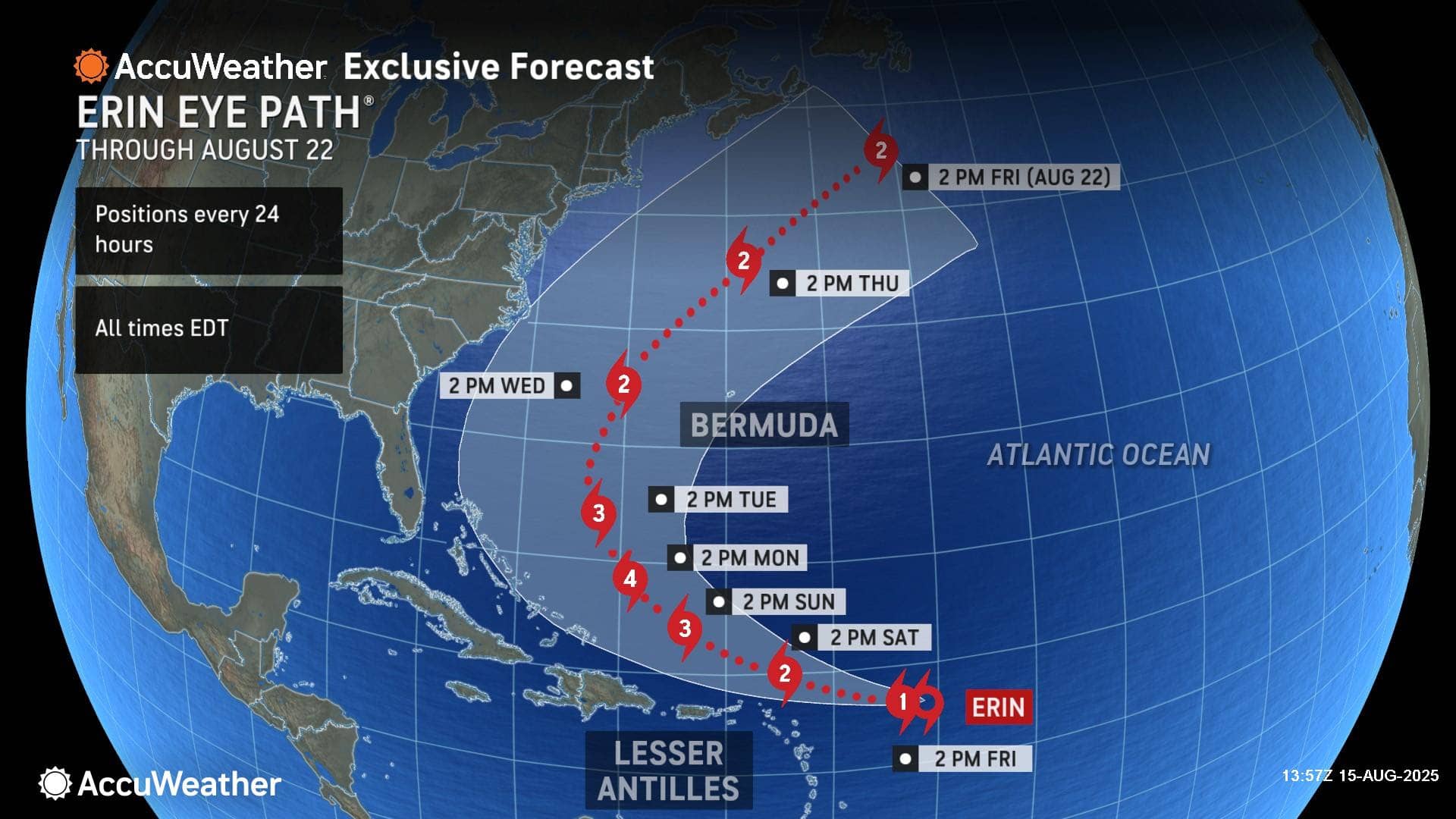
AccuWeather® hurricane experts say Erin is expected to reach Category 4 hurricane strength in the open Atlantic late this weekend or early next week as it curves to the north, bringing dangerous rough surf and rip currents to the East Coast of the United States.
“Erin is forecast to explode into a powerful Category 4 hurricane as it moves across very warm waters in the open Atlantic. Water temperatures at the surface and hundreds of feet deep are several degrees higher than the historical average,” AccuWeather® Lead Hurricane Expert Alex DaSilva said. “Erin will move into an area with little dry air and very low disruptive wind shear. Atmospheric conditions will be near perfect for rapid intensification as it curves to the north.”
Caribbean Impacts Expected
AccuWeather® hurricane experts say locally heavy rain and gusty winds from the outer bands will impact the northern Leeward Islands from Antigua and Barbuda through Puerto Rico this weekend.
Erin is currently forecast to pass north of Puerto Rico by roughly 200 miles as a Category 3 hurricane.
Storm surge of 1-3 feet is expected to impact beaches across the region this weekend.
Download the latest AccuWeather® forecast graphics
“The core of the storm is forecast to pass north of Puerto Rico. Outer rain bands will have the potential of unleashing torrential rainfall that could trigger flash flooding and localized mudslides over the weekend into early next week,” DaSilva warned. “Gusty winds could bring down trees and power lines. People on the island should be prepared for the possibility of power outages.”
Due to expected impacts from rain, wind and storm surge, Erin currently rates as less than one on the AccuWeather RealImpact™ Scale for Hurricanes in the Caribbean.
A rating of less than one on the AccuWeather RealImpact™ Scale for Hurricanes indicates limited damage potential from wind and rain, as well as some coastal inundation capable of causing property damage.
Coastal hazards along the U.S. East Coast
AccuWeather® hurricane experts are urging people, businesses, and officials along the East Coast to closely monitor forecast updates over the weekend, as a shift in the track could bring direct impacts.
Rough surf and dangerous rip currents are expected next week along the entirety of the East Coast from South Florida to Canada. Beach erosion is also likely along the southeastern Virginia and North Carolina coast, especially in the Outer Banks.
Download the latest AccuWeather® forecast graphics
“Erin is forecast to slowly curve to the north as it strengthens over the weekend. At this time, the storm is forecast to remain hundreds of miles off the East Coast. Major hurricanes can produce massive waves,” DaSilva explained. “Beaches along the entire East Coast, from Florida to New England and Atlantic Canada, will likely experience rough surf and dangerous rip currents as Erin tracks north and eventually northeast. Waves reaching 10 to 15 feet along the Outer Banks could cause beach erosion problems next week.”
AccuWeather® hurricane experts say there is the possibility that an area of high pressure, known as the Bermuda High, will extend well to the west. This, paired with a cold front and a dip in the jet stream over the eastern U.S., could also allow Erin to track significantly farther to the west. This farther west scenario would mean a greater risk of strong winds, rain and coastal flooding impacts to areas reaching eastern North Carolina, Long Island, New York and southeastern New England.
The most likely scenario forecasts Erin remaining several hundred miles off the U.S. coast. August hurricane climatology supports this, with most of the hurricanes that have tracked in a similar manner to Erin up to this point curving back to the northeast and moving into the open Atlantic.
Bermuda on alert
AccuWeather® hurricane experts forecast Erin to pass to the west of Bermuda next week. Depending on the exact track, it is possible that the storm can bring significant rain and wind impacts to Bermuda, as well as dangerous seafaring conditions and hazardous shore impacts, including swell and strong rip currents.
Download the latest AccuWeather® forecast graphics
People in Bermuda are being urged to prepare for wind gusts up to 60-80 mph next week, with an AccuWeather Local StormMax™ of 100 mph. These winds can down trees and cause localized power outages. AccuWeather hurricane experts forecast 2-4 inches of rainfall in Bermuda next Tuesday through Thursday, with an AccuWeather Local StormMax™ of 8 inches.
“Waves near the center of this storm could top 50 or even 75 feet next week as Erin passes to the north and west of Bermuda,” DaSilva said. “People on the island should be prepared for rough seas, rip currents, wind gusts reaching 60 to 80 mph, and several inches of rainfall.”
Eye on the Tropics
AccuWeather hurricane experts are urging people to check emergency supplies, review evacuation zones and routes, and ensure insurance policies are up to date, as the climactic peak of hurricane season quickly approaches.
The historical average date for the first Atlantic hurricane is Aug. 11. Typically, the fifth named storm forms around Aug. 22. The first major hurricane in the Atlantic basin typically occurs around Sept. 1.
AccuWeather hurricane experts are monitoring two additional areas at low risk of tropical development potential in the main development region of the Atlantic basin, near the area where a tropical rainstorm formed last week that developed into Erin.
Download the latest AccuWeather® forecast graphics
“Erin will churn up the Atlantic Ocean, leaving cooler waters in its wake. Water temperatures will likely rebound within a few days after the storm passes, creating conducive conditions for additional tropical development later this month,” DaSilva said. “Two tropical waves expected to push across the Atlantic later this month, following a similar route to Erin, will be closely monitored.”
AccuWeather hurricane experts are also monitoring an area with a medium risk of tropical development potential in the western Gulf through Friday night.
Download the latest AccuWeather® forecast graphics
“A surge of tropical moisture is expected to soak parts of southern and central Texas, regardless of tropical development. People in areas prone to flash flooding should be on alert,” DaSilva said. “Downpours could impact ongoing recovery operations in areas devastated by the Independence Day flash flood disaster in the Texas Hill Country.”
The AccuWeather® 2025 Atlantic Hurricane Season Forecast predicts 13 to 18 named storms, including seven to 10 hurricanes and three to five major hurricanes that reach Category 3 strength or higher on the Saffir-Simpson Hurricane Wind Scale. A Category 3 hurricane has sustained winds between 111 and 129 miles per hour.
AccuWeather® is forecasting three to six direct impacts to the U.S. this year, which is the same range AccuWeather® forecast for the historic 2024 Atlantic hurricane season. AccuWeather® was the first known source to issue an Atlantic hurricane season forecast in March.
AccuWeather® hurricane experts issued an update in May, urging people, businesses, officials and emergency responders to prepare for an increased risk of flooding and tornado impacts reaching far inland after landfall, similar to last year.
Advertise with the mоѕt vіѕіtеd nеwѕ ѕіtе іn Antigua!
We offer fully customizable and flexible digital marketing packages.
Contact us at [email protected]

















